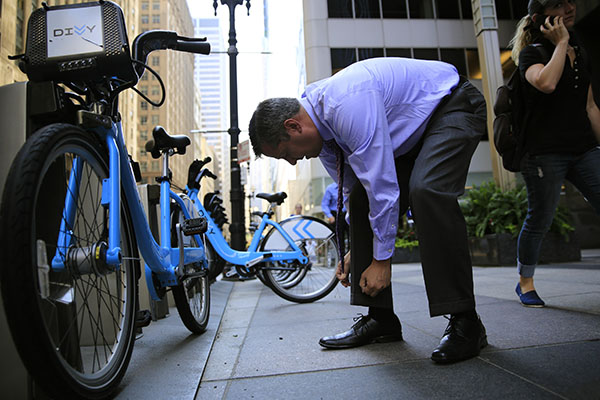
Photo: Chris Walker/Chicago Tribune
Attorney Bill Choslovsky prepped his trouser leg for a Divvy ride on LaSalle near Madison last Friday.
Divvy, Chicago’s first large-scale bike share program, has come a long way since it opened to the public in June. Early naysayers have changed their tune as the system has netted 150,000 rides, 5,000 annual memberships, and 37,000 single-day passes. Divvy riders have logged more than 458,000 miles on trips averaging about 18 minutes, according to the Chicago Tribune.
Those who Divvy are often rookie riders, though, and they do make mistakes. The system is designed for quick trips over short distances, and riders with limited knowledge of Divvy’s rules—and city biking in general—have had plenty of problems in the last two months.
As the system continues to grow, riders will no doubt improve. To help everyone out in the meantime, Chicago got in touch with Streetsblog Chicago writer Steve Vance to find out how new riders can ride the right way—or well enough, at least, to avoid ending up in a post about dumb Divvy mistakes.
Here's what Vance had to say:
Keep rides short. This seems to be where most people get tripped up, Vance says. Divvy offers a $75 annual membership and a $7 24-hour pass. But the system is intended for short trips, meaning both options require you to dock your bike every 30 minutes.
Overtime fees start at $2 and increase every half hour. You could keep the bike for an hour and still only pay $9, which isn't so bad, but the next half hour would cost you an additional $4. Tack on $8 for every 30 minutes after that, and you're looking at nearly 40 bucks for a three-hour trip.
You could theoretically keep mobile for the full 24 hours by checking in frequently, but that doesn't make for a very leisurely cruise. If you want to ride around all day, you'd be better off renting from a bike shop.
Use a map. “Chicago has a really low connectivity network, where not all bike lanes hook up with other bike lanes,” Vance says. Some areas, like Madison Street in the Loop, have bike lanes going west but none for eastbound travel.
A paper map, Google Maps, or a phone app like Vance’s Chicago Bike Guide can help you find the best routes. Plan ahead and mark the Divvy docks along your path to ensure you don't rack up overtime charges hunting down a place to check in.
Get off the sidewalks! Although Divvy instructs riders to walk their bikes on sidewalks, many people (especially tourists) are a little uneasy about riding on the street. The fear is understandable given the animosity between drivers and bicyclists in the U.S. But riding on a busy sidewalk could be just as dangerous if you hit a pedestrian or get knocked into traffic. There’s almost always a way to take a less vehicle-heavy side street to get where you're going.
Ride like you would drive. Acclimating to biking on the road isn’t so hard once you realize the rules are pretty much the same as driving a car. You don’t have a huge metal frame or airbag system to protect you in a crash, but that just means you should take extra care to anticipate stop lights and signal turns. (Stick your left arm straight out to signal a left turn, or angle your left forearm upward to make a right.) And don’t blow through stop signs.
“As far as safety goes, stick to the bike lanes and stop at all the stop lights,” Vance says. “Imagine that you were driving a car. Which rules would you be following?”



